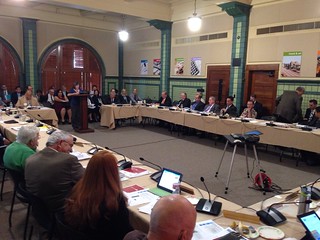 A joint or shared use agreement is a formal agreement between two groups, for example a school district and a city or county, which allows for the use of public property, like a school playground or field, after regular school hours. Shared use agreements can help school districts save money on the development, operation, and maintenance of the facilities that will be shared..
A joint or shared use agreement is a formal agreement between two groups, for example a school district and a city or county, which allows for the use of public property, like a school playground or field, after regular school hours. Shared use agreements can help school districts save money on the development, operation, and maintenance of the facilities that will be shared..
Resource Library
This report demonstrates how Safe Routes to School is a collaborative effort involving multiple organizations, including state Departments of Education and state Departments of Public Health.
 In March 2013, the American Diabetes Association released their most recent five-year update “The Economic Cost of Diabetes in the US in 2012,” which found that in 2012, diabetes cost the US a total of $245 billion, an increase of 41 percent from 2007.
In March 2013, the American Diabetes Association released their most recent five-year update “The Economic Cost of Diabetes in the US in 2012,” which found that in 2012, diabetes cost the US a total of $245 billion, an increase of 41 percent from 2007.
This policy brief provides information about these programs and ways that school districts/county offices of education (COEs) can become involved in increasing active transportation to and from school.
 Just shy of one year since the passage of the new transportation law, MAP-21, the US Department of Transportation has issued the final guidance and a
Just shy of one year since the passage of the new transportation law, MAP-21, the US Department of Transportation has issued the final guidance and a
This report describes a process that can be used in any state to bring together diverse partners, create a SRTS State Network, and initiate policy changes that will make it safer and easier for children to be able to walk and bicycle to schools.
 Looking back, I never would have imagined that many of the recreational activities I participated in and enjoyed, especially walking and bicycling to school, climbing ropes in PE, hiking to the local nature center, and playing games at recess, would impact my life so significantly.
Looking back, I never would have imagined that many of the recreational activities I participated in and enjoyed, especially walking and bicycling to school, climbing ropes in PE, hiking to the local nature center, and playing games at recess, would impact my life so significantly.
This webinar from November 6, 2013 provides examples and key resources to assist in starting conversations about shared use and building relationships with school board members, school administrators and principals.
 In honor of July being Parks and Recreation month, I decided to focus on how we, as Safe Routes to School advocates, can ensure that all children have the ability to be active outside all year round. Just like walking and bicycling to school, access to parks and recreation can directly impact the overall quality of life for children.
In honor of July being Parks and Recreation month, I decided to focus on how we, as Safe Routes to School advocates, can ensure that all children have the ability to be active outside all year round. Just like walking and bicycling to school, access to parks and recreation can directly impact the overall quality of life for children.
This resource is a policy statement that describes the goals of the Georgia Safe Routes to School Regional Network.
 Last week, the US Department of Transportation (USDOT) released their draft strategic plan for FY2014-2018. This plan will drive the USDOT’s internal workplan, so it’s important to make sure Safe Routes to School, bicycling and walking is well-represented.
Last week, the US Department of Transportation (USDOT) released their draft strategic plan for FY2014-2018. This plan will drive the USDOT’s internal workplan, so it’s important to make sure Safe Routes to School, bicycling and walking is well-represented.
The federal Safe Routes to School program provides funds to support programs in each state to ensure that it is safe and easy for children to walk and bicycle to school.
This webinar from September 5, 2013 focuses on working with middle school youth and looks at programs that have effectively engaged youth in active transportation.
 In early November 2013, the San Bernardino Association of Governments (SANBAG) board adopted a historic Memorandum of Understanding (MOU) (Item 7) with the Southern California Association of Governments (SCAG). The MOU commits the two agencies to working together on projects related to the implementation of the 2012 Regional Transportation Plan and Sustainable Communities Strategy (RTP/SCS). While the RTP/SCS is mandated by SB 375, state legislation to reduce greenhouse gas emissions through trying land use and transportation planning in the RTP process, the MOU is strictly voluntary.
In early November 2013, the San Bernardino Association of Governments (SANBAG) board adopted a historic Memorandum of Understanding (MOU) (Item 7) with the Southern California Association of Governments (SCAG). The MOU commits the two agencies to working together on projects related to the implementation of the 2012 Regional Transportation Plan and Sustainable Communities Strategy (RTP/SCS). While the RTP/SCS is mandated by SB 375, state legislation to reduce greenhouse gas emissions through trying land use and transportation planning in the RTP process, the MOU is strictly voluntary.
The MOU between SCAG and SANBAG demonstrates both agencies’ commitment to the policies, projects and strategies set forth in the 2012 RTP/SCS. It is important for County Transportation Commissions (CTCs) to show commitment to implementation of plans and policies.
Specific planning projects are included in SANBAG’s MOU that will transform San Bernardino County into a more walkable and bikeable place, improve the public health outcomes of its residents and help increase the number of children walking and bicycling to school. The MOU incorporates items recommended in the San Bernardino Active Transportation Vision, statistics and policy recommendations developed by stakeholders from San Bernardino County, including SANBAG staff, San Bernardino County Department of Public Health, Omnitrans, Safe Routes Partnership, American Lung Association, MoveIE and Inland Empire Bicycle Alliance.
This report explores environmental health and Safe Routes toSchool through a review of the relationship between environmental health and school travel, a discussion on measuring the environmental health impacts of school travel, and five examples of methods used by SRTS programs to estimate the impact of their activities on local air quality.

Did you know that about 45 percent of Americans make New Year’s resolutions each year? As you can guess, favorite resolutions include losing weight, exercising more, and saving more money. Do you also know that ultimately only about 8 percent of resolutions are sustained?
These briefings sheets were developed with funding support from the National Center for Safe Routes to School. The briefing sheets are intended for use by transportation engineers and planners to support their active participation in the development and implementation of Safe Routes to School programs and activities.
 When I see children walking to or from school, I notice their interactions. They talk, laugh, and maybe drop their bags to engage in a spontaneous race. They move in pairs or small pods. There’s a special kind of connection as they transition to school or home. It’s an image which brings me hope.
When I see children walking to or from school, I notice their interactions. They talk, laugh, and maybe drop their bags to engage in a spontaneous race. They move in pairs or small pods. There’s a special kind of connection as they transition to school or home. It’s an image which brings me hope.
This document explains a process to help transportationprofessionals identify schools within a city, schooldistrict or other local jurisdiction that meritadditional review for specific pedestrianinfrastructure improvements based on safetyconsiderations.


